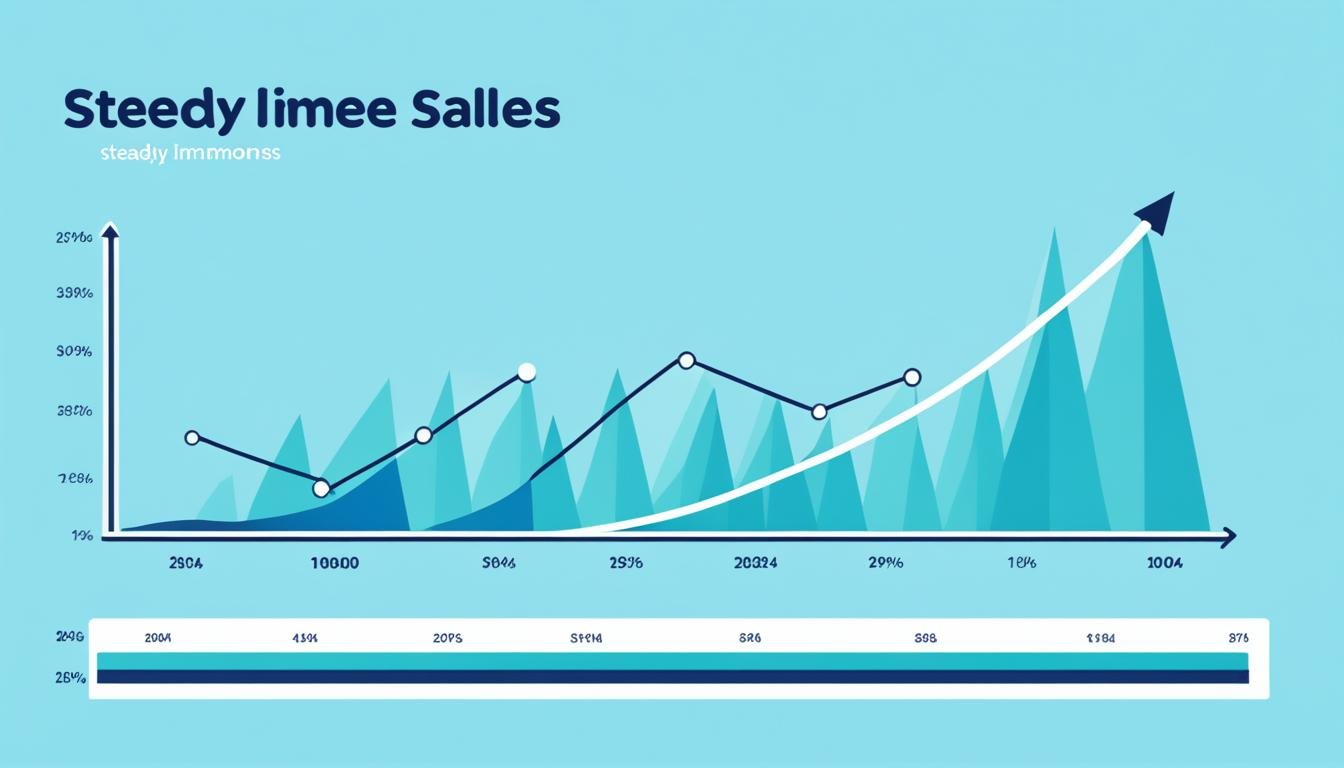Sales Analytics: Measuring and Improving Performance
In today’s competitive world, a strong sales team is key to success. But how do you know if your team is doing its best? Sales analytics can be the answer. It’s a powerful tool that can change your sales strategy and lead to great success.
Key Takeaways
- Understanding the importance of data-driven sales strategy to improve overall performance
- Identifying key sales performance metrics and KPIs to measure team and individual success
- Leveraging sales analytics to gain deeper insights into customer behavior and sales trends
- Optimizing sales productivity and pipeline management through data-driven decision making
- Overcoming challenges in measuring and improving sales performance with the right approach
We’re going to explore sales analytics and how it can help your team. We’ll talk about setting goals and using data to make smart choices. These strategies will help your business succeed like never before.
Understanding Sales Performance
Sales performance shows how well a sales team turns leads into customers and makes money. It’s key to your business’s growth. It shows how good your team and strategies are. Things like competition, product quality, and what customers expect can affect sales.
What is Sales Performance?
Sales metrics give us the numbers. Sales performance metrics look at the quality and how efficient those numbers are. This helps us see what’s working and what’s not in sales. By looking at sales performance, we can make our business and customer relationships stronger.
Importance of Analyzing Sales Performance
Knowing where your best sales come from helps you focus on those areas. It lets you make products that meet what customers want. By looking at sales data, your sales and marketing team gets to know their strengths and weaknesses.
This helps them make better choices. It makes your team work together better, adapt, and aim for clear goals. Using sales performance analysis helps you make smart, data-driven decisions. This leads to continuous improvement in your sales goals and accountability.
“Up to 90% of B2B sellers don’t use sales materials because they’re not relevant or up-to-date. Sales content analytics can show what content is most engaging and relevant to potential buyers.”
Key Sales Performance Metrics
It’s vital to track the right sales performance metrics to manage and boost your sales. These metrics cover quantity, quality, efficiency, and productivity.
Quantity Metrics show how active your sales team is. They track outreach calls, successful deals, and the average deal size. This helps you see how big your sales efforts are.
Quality Metrics look at how well your team turns leads into customers and keeps them happy. They include win rate, conversion rate, customer satisfaction (CSAT), and Net Promoter Score (NPS).
- Total Revenue: The total revenue from sales.
- Net Revenue Retention (NRR): The recurring revenue kept from current customers.
- Repeat Customer Rate: The number of customers who buy more than once.
- Average Customer Lifetime Value (LTV): The total value a customer will bring over time.
Efficiency Metrics check how fast and well your sales work, pointing out areas to improve. They look at sales cycle length and how quickly you respond to leads.
Productivity Metrics show the return on your sales team’s work. They cover customer churn rate, revenue growth, and meeting sales targets.
By keeping an eye on these key metrics, you understand your sales better. This helps you make smart decisions to improve your sales strategy and grow sustainably.
“Measure what matters, and you’ll know what to improve.” – Peter Drucker
Sales Analytics: Measuring and Improving Performance
In the world of sales, data is key to success. A sales performance dashboard lets you see all important sales metrics in one spot. This tool helps sales managers and executives make data-driven decisions by spotting trends and areas for improvement.
Sales performance dashboards set clear sales goals and boost accountability in the sales team. They track performance over time and compare it to past data and industry standards. This leads to continuous improvement and growth. It helps sales teams make smart choices, refine their strategies, and increase sales and customer happiness.
“Leveraging sales analytics is the key to unlocking your sales team’s full potential. With a data-driven approach, you can make smarter decisions, set more realistic goals, and drive sustainable growth.”
A well-designed sales performance dashboard gives a full view of your sales operations. It helps you spot areas to improve, use resources better, and encourage data-driven decisions in your sales team.
By using sales analytics, you can boost your sales team’s performance and take your business higher. Whether you want to increase sales, improve lead conversion, or shorten your sales cycle, a strong sales performance dashboard can help you reach your goals.
Challenges in Measuring Sales Performance
Measuring sales performance is key but tricky for businesses. First, pick the right metrics that match your sales goals. This means choosing key performance indicators (KPIs) that cover everything from getting leads to closing deals.
Identifying the Right Metrics
Finding the right sales metrics can be tough. You should pick them based on your business goals and sales team targets. Important metrics include sales funnel tracking, lead conversion rates, average deal size, and customer lifetime value. These help spot problems in the sales process and guide better decisions.
Data Accuracy and Integration
Even with good plans, sales goals and actual performance can mismatch. It’s vital to keep your sales data accurate and well-integrated. Check your data sources often, spot where performance is off, and catch issues early. This ongoing check helps fine-tune your sales plans and keep them in line with your business goals.
Measuring sales performance is a constant challenge. But by choosing the right metrics, keeping data accurate, and integrating performance data, you can get insights to improve and hit your sales targets.
“Reps contacting leads within an hour are seven times more likely to qualify the lead. Waiting a full 24 hours to contact a lead might result in being 60 times less likely to qualify the lead.”
Strategies for Improving Sales Performance
Improving your sales team’s performance takes a detailed plan. Sales onboarding and training are key to giving new sellers the right skills. With good onboarding, you help them start strong and reach their best performance faster.
Keeping up with sales training is also vital. It helps sellers improve their skills, keep up with market changes, and use best practices. Adding sales coaching and feedback lets your team work on their weak spots and use their strengths well.
Sales enablement gives sellers the tools and resources they need. This makes the sales process smoother and boosts their productivity. It helps them connect better with buyers and close more deals.
Lastly, optimizing the sales process can greatly improve performance. By looking at sales metrics like lead response rate and customer lifetime value, you can find ways to get better. This lets you make smart choices to improve your sales strategies.
“Improving sales performance is not a one-time event, but a continuous journey of learning, adapting, and optimizing.” – Jane Doe, Sales Strategist
With these strategies, you can help your sales team reach their full potential. This leads to lasting growth for your business.
Conclusion
Measuring sales performance is key to boosting a business. By tracking important metrics and using a sales dashboard, companies can align sales with business goals. This leads to data-driven sales strategies and a focus on continuous improvement.
Having a strong sales team is crucial. Regular feedback and coaching help improve sales performance. This focus on the sales process is vital for long-term success.
To grow sales sustainably, businesses must keep an eye on their data. They should regularly check sales metrics and see which products do best. Understanding customer behavior helps make better sales strategies.
Using data to manage sales helps unlock team potential. This approach prepares companies for success in a tough market.
Success in sales comes from always improving and adapting to changes. Knowing the right metrics is key. With strong sales analytics, companies can find new chances, improve sales processes, and build a top-performing team.
Source Links
- Sales Performance Guide: How to Measure & Improve Sales Metrics [2024]
- Performance In Sales – Measure & Improve
- How to Measure & Improve Sales Performance | Seismic
- Sales Metrics 101: The Ultimate Guide to Understand What to Track, How to Track, & Why
- All You Need to Know About Measuring Sales Content Performance
- Measuring sales performance: The 16 key metrics that highly productive teams monitor
- 15 Essential Sales Performance Metrics
- Measuring sales performance to identify areas for improvement and drive growth
- How to Measure Sales Performance: A Guide for Business Success
- Sales performance metrics to drive high-performing sales teams
- How to Measure Sales Performance Metrics and KPIs
- Marketing Performance Measurement – Challenges & Solutions | Factors Blog
- Sales Performance | Sales Performance Measurements
- How to Track and Measure Sales Performance Effectively – noupe
- How to Perform a Sales Analysis (Step-by-Step): Methods & Metrics
- Sales Analytics 101: Everything You Need To Know (2023) – Shopify







